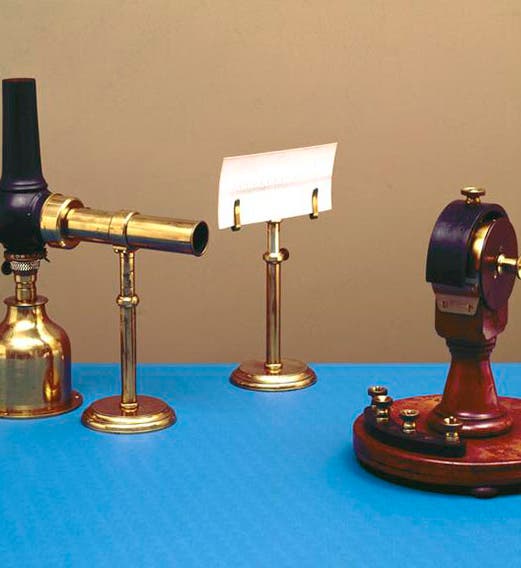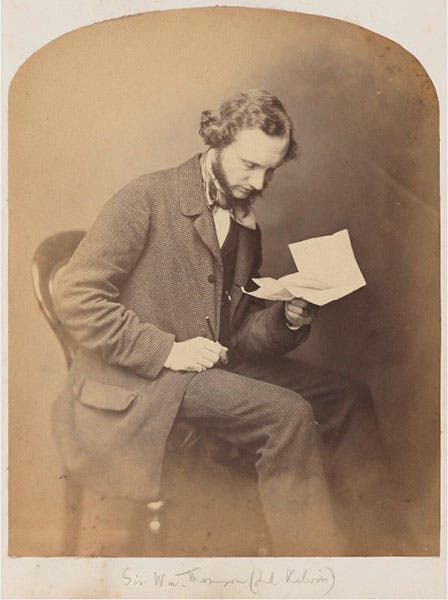Scientist of the Day - William Thomson, Lord Kelvin
William Thomson, a British physicist, died Dec. 17. 1907, at the age of 83. At the time of his death, Thomson, now universally referred to as Lord Kelvin, was the most famous physicist in the world, the Einstein of Victorian England. But his most influential achievements came fifty years earlier, when he was an up-and-coming physicist at the University of Glasgow (where he would teach from 1846 to 1899)
The first of his noted feats was the development, in the early 1850s, of the Second Law of Thermodynamics, the one known as the Law of Entropy, which states that in any closed system, energy becomes increasingly unavailable for work, and systems run down. The third, a consequence of the first, was that the Earth itself is a cooling body, and its age can be calculated from its rate of cooling. Thomson deduced that age to be 100 million years or so, thus greatly confounding geologists and naturalists like Charles Dawin, who needed billions of years for the scenario of evolution by natural selection to play out. Only with the discovery that the Earth is warmed by radioactive heat, made in 1903, would the basis for Thomson’s young age for the Earth be undermined.
We wrote about both of these developments in our first post on Thomson. Today, we look at the feat in between, Thomson’s contribution to the laying of the first trans-Atlantic cables, which was a major contribution indeed. The Atlantic Telegraph Company had been formed in 1856, a joint British-American effort, with the goal of laying a telegraph cable from Ireland to Newfoundland. Thompson became involved when he was asked to calculate the obstacles to obtaining a reasonable transmission rate presented by a 2000-mile-long cable. His work was so insightful – no one else working on the cable project had such mathematical expertise – that Thomson was invited to join the Boad of Directors of the company.
At first, Thomson was a bit of a fish out of water, in that the company already had a chief engineer, Charles Bright, and a chief electrician, Wildman Whitehouse. Whitehouse invented all sorts of new equipment for detecting faint signals, and powerful induction coils to make sure the signal could make it through 2000 miles of copper cable. But when they attempted to lay the first cable in 1857, it became evident that Whitehouse’s detectors were not sensitive enough. Incidentally, on that first attempt, Thompson was overseeing electrical matters on board the Agamemnon, the British ship responsible for laying cable from the mid-Atlantic to Valentia, Ireland, while Whitehouse stayed ashore, pleading illness.
Since the detectors onboard ship could not pick up the faint cable signals, Thomson, early in 1858, invented a new type of detector, called a mirror galvanometer. A galvanometer is just a coil that moves a needle when an electrical current runs through it. Ordinary galvanometers failed to budge when a weak signal went through its coils. In Thomson’s new instrument, the coil rotated a mirror slightly when it detected a current, and a light beam was bounced off the mirror onto a scale. The signal was thus amplified by an enormous factor, so that you could easily see a blip of light move across the scale, even though you could hardly see the mirror move at all (first and fourth images).
A second attempt was made at laying a cable in 1858, with the same two ships (the American ship Niagara was responsible for the leg from mid-Atlantic to Newfoundland), but it failed as well. They almost gave up, but since they still had 2000 miles of cable in the ships’ holds, they decided to give it one last shot. And this time, they were successful, completing the cable from Valentia to St. John’s on Aug 5, 1858. Again, Thomson was onboard ship for the entire cable-laying operation, and the chief electrician Whitehouse was not.
Success and jubilation were short-lived, as the shore stations found that the cable had a short somewhere and signals were too weak to be detected. The shore stations were still using Whitehouse’s detectors, but when they switched to Thomson’s mirror galvanometers, the signals could be detected and deciphered. The 1858 cable finally failed completely after a month of intermittent operation, but Thomson now knew how to build a better cable and how to transmit and receive signals with efficiency. Whitehouse was held accountable by a board of inquiry for ruining the 1858 cable by zapping it with his induction coils, and he was fired. Thomson took over and successfully engineered the electrical part of the 1865 and 1866 cable efforts (the 1865 cable failed at first and had to be grappled and spliced by the 1866 expedition, but both were ultimately successful). His contributions were considered so valuable that he was almost immediately knighted by the Queen after the cable success of 1866.
One of Thomson’s galvanometers from 1858 is in the Science Museum of London, although it is hard to see from the photos how it worked (first image). You might prefer a diagram (third image). As we mentioned in our post on Whitehouse, the best source on the scientific aspect of the five cable-laying efforts of 1857-1866, or at any rate, the one I prefer, is a book by Bruce J. Hunt, Imperial Science: Cable Telegraphy and Electrical Physics in the Victorian British Empire (Cambridge Univ. Press, 2021). Also, in our post on Whitehouse, I provided some links to other posts that discuss the scientists involved in the various attempts to lay a trans-Atlantic cable. You could check those out if you are interested.
William B. Ashworth, Jr., Consultant for the History of Science, Linda Hall Library and Associate Professor emeritus, Department of History, University of Missouri-Kansas City. Comments or corrections are welcome; please direct to ashworthw@umkc.edu.










